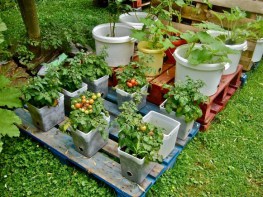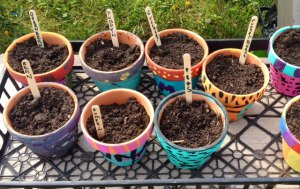Want to garden but don’t have a space? Tools? Permanent location…
I have gained some container gardening knowledge by being a bit of a nomad, bringing my potted herbs, strawberries, rhubarb and other perennials with me as I moved around.
Although I learned a lot through trial and error, there was still much to learn!
This summer we have started a demonstration garden beside the Theresa Cremo Memorial Health Centre in Waycobah where we host gardening workshops. Those who attend the workshops are excited about the gardens and although there is a diverse range of gardening experience and knowledge within the group, a common question amongst the group seems to be, “How can I do something like this at my house?”
There is no doubt that certain obstacles can get in the way of gardeners, regardless of their gardening experience. Obstacles may be around land size, access to materials, or knowledge of how to construct a raised bed. These issues can easily discourage gardeners. Workshop participants seemed surprised whenever we would mention growing in containers. Although some community members were familiar with growing tomatoes in pots, there were unaware of the variety of fruits, vegetables and herbs that can be grown in smaller spaces. Prior to the workshop I did some reading and a bit more digging (literally), and felt well equipped to facilitate a workshop with the eager gardeners in Waycobah. My kids also gained from my preparations as we toured the various ice cream barns in Inverness County collecting ice cream buckets for the event.
Thinking INSIDE the box; there are a few things to consider when planting in containers.
- Containers being used should be food safe or free of any chemicals or
paint, but that doesn’t mean you can’t be creative with what you
creative with what you
plant in. - Containers should have adequate drainage. Some ways to achieve this are by puncturing the bottom with holes, or using stones or peat in the bottom of containers.
- Keep your plants moist. Because they are grown above ground they will dry out faster, but take care not to over water.
- Container depth. Tomatoes, corn, potatoes, beets and eggplant
require more space and depth than lettuces and herbs which will do well in 8 inch containers.
http://www.communitygroundworks.org/sites/default/files/container_gardening_manual.pdf
Another important factor is location, location, location.
Where are the pots? Are they in the sun? The shade? Different types of plants have different growing requirements. Tomatoes, strawberries and other fruit bearing plants will be more productive, producing a greater yield, if they are placed somewhere sunny. Shade loving plants such as lettuces, kale, and spinach will do well in a location that only receives three or four hours of sun per day. Some root vegetables such as beets and carrots will also do well in partial shade.
During our container gardening workshop, participants experimented with vegetable seeds they have never tried before. Arugula is now growing on everyone’s patio! There was also a mini impromptu seed exchange and I am honoured to be growing some traditional ceremonial plants alongside my tomatoes. The excitement around container gardening carried over to our DIG IT! Kid’s gardening camp in Wagmatcook and some young enthusiasts showed off their green (or rainbow coloured!) thumbs as they started seeds in the vibrant terracotta pots they painted.

So for those of you who are facing some barriers around starting a garden, go treat yourself to an ice cream, pick up some empty ice cream buckets, and happy planting!
Amanda Leigh Mac Innis
Summer Student
Our Food Program
Cape Breton



